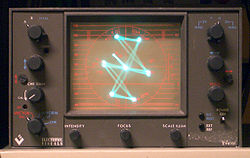
Vectorscope
Encyclopedia


Oscilloscope
An oscilloscope is a type of electronic test instrument that allows observation of constantly varying signal voltages, usually as a two-dimensional graph of one or more electrical potential differences using the vertical or 'Y' axis, plotted as a function of time,...
used in both audio and video applications. Whereas an oscilloscope or waveform monitor normally displays a plot of signal vs. time, a vectorscope displays an X-Y plot of two signals, which can reveal details about the relationship between these two signals. Vectorscopes are highly similar in operation to oscilloscopes operated in X-Y mode; however those used in video applications have specialized graticules, and accept standard television or video signals as input (demodulating
Demodulation
Demodulation is the act of extracting the original information-bearing signal from a modulated carrier wave.A demodulator is an electronic circuit that is used to recover the information content from the modulated carrier wave.These terms are traditionally used in connection with radio receivers,...
and demultiplexing the two components to be analyzed internally).
Video
In video applications, a vectorscope supplements a waveform monitorWaveform monitor
A waveform monitor is a special type of oscilloscope used in television production applications. It is typically used to measure and display the level, or voltage, of a video signal with respect to time....
for the purpose of measuring and testing television signals, regardless of format (NTSC
NTSC
NTSC, named for the National Television System Committee, is the analog television system that is used in most of North America, most of South America , Burma, South Korea, Taiwan, Japan, the Philippines, and some Pacific island nations and territories .Most countries using the NTSC standard, as...
, PAL
PAL
PAL, short for Phase Alternating Line, is an analogue television colour encoding system used in broadcast television systems in many countries. Other common analogue television systems are NTSC and SECAM. This page primarily discusses the PAL colour encoding system...
, SECAM
SECAM
SECAM, also written SÉCAM , is an analog color television system first used in France....
or any number of digital television
Digital television
Digital television is the transmission of audio and video by digital signals, in contrast to the analog signals used by analog TV...
standards). While a waveform monitor allows a broadcast technician to measure the overall characteristics of a video signal, a vectorscope is used to visualize chrominance
Chrominance
Chrominance is the signal used in video systems to convey the color information of the picture, separately from the accompanying luma signal . Chrominance is usually represented as two color-difference components: U = B' − Y' and V = R' − Y'...
, which is encoded into the video signal as a subcarrier of specific frequency. The vectorscope locks exclusively to the chrominance subcarrier in the video signal (at 3.58 MHz for NTSC, or at 4.43 MHz for PAL) to drive its display. In digital applications, a vectorscope instead plots the Cb and Cr channels against each other (these are the two channels in digital formats which contain chroma information).
A vectorscope uses an overlaid circular reference display, or graticule, for visualizing chrominance signals, which is the best method of referring to the QAM
Quadrature amplitude modulation
Quadrature amplitude modulation is both an analog and a digital modulation scheme. It conveys two analog message signals, or two digital bit streams, by changing the amplitudes of two carrier waves, using the amplitude-shift keying digital modulation scheme or amplitude modulation analog...
scheme used to encode color into a video signal. The actual visual pattern that the incoming chrominance signal draws on the vectorscope is called the trace. Chrominance is measured using two methods—color saturation
Saturation (color theory)
In colorimetry and color theory, colorfulness, chroma, and saturation are related but distinct concepts referring to the perceived intensity of a specific color. Colorfulness is the degree of difference between a color and gray. Chroma is the colorfulness relative to the brightness of another color...
, encoded as the amplitude
Amplitude
Amplitude is the magnitude of change in the oscillating variable with each oscillation within an oscillating system. For example, sound waves in air are oscillations in atmospheric pressure and their amplitudes are proportional to the change in pressure during one oscillation...
, or gain
Gain
In electronics, gain is a measure of the ability of a circuit to increase the power or amplitude of a signal from the input to the output. It is usually defined as the mean ratio of the signal output of a system to the signal input of the same system. It may also be defined on a logarithmic scale,...
, of the subcarrier signal, and hue
Hue
Hue is one of the main properties of a color, defined technically , as "the degree to which a stimulus can be describedas similar to or different from stimuli that are described as red, green, blue, and yellow,"...
, encoded as the subcarrier's phase
Phase (waves)
Phase in waves is the fraction of a wave cycle which has elapsed relative to an arbitrary point.-Formula:The phase of an oscillation or wave refers to a sinusoidal function such as the following:...
. The vectorscope's graticule roughly represents saturation as distance from the center of the circle, and hue as the angle, in standard position, around it. The graticule is also embellished with several elements corresponding to the various components of the standard color bars video test signal
Test Pattern
Test Pattern may refer to:* Test Pattern , a Canadian game show* Test Pattern , an album by Sonia Dada* Test pattern or test card, a television test signal...
, including boxes around the circles for the colors in the main bars, and perpendicular lines corresponding to the U and V components of the chrominance signal (and additionally on an NTSC vectorscope, the I and Q components). NTSC vectorscopes have one set of boxes for the color bars, while their PAL counterparts have two sets of boxes, because the R-Y chrominance component in PAL reverses in phase on alternating lines. Another element in the graticule is a fine grid at the nine-o'clock, or -U position, used for measuring differential gain
Differential gain
Differential gain is a kind of linearity distortion which affects the color saturation in TV broadcasting.- Composite color video signal :Composite color video signal consists of three terms:*Luminance signal...
and phase
Differential phase
Differential phase is a kind of linearity distortion which affects the color hue in TV broadcasting.- Composite color video signal :Composite color video signal consists of three terms:*Monochrome signal...
.
Often two sets of bar targets are provided: one for color bars at 75% amplitude and one for color bars at 100% amplitude. The 100% bars represent the maximum amplitude (of the composite signal) that composite encoding allows for. 100% bars are not suitable for broadcast and are not broadcast-safe
Broadcast-safe
Broadcast-safe video is a term used in the broadcast industry to define video and audio compliant with the technical or regulatory broadcast requirements of the target area or region the feed might be broadcasting to...
. 75% bars have reduced amplitude and are broadcast-safe.
In some vectorscope models, only one set of bar targets is provided. The vectorscope can be set up for 75% or 100% bars by adjusting the gain so that the color burst
Colorburst
Colorburst is a analog video, composite video signal generated by a video-signal generator used to keep the chrominance subcarrier synchronized in a color television signal...
vector extends to the "75%" or "100%" marking on the graticule.
The reference signal used for the vectorscope's display is the color burst that is transmitted before each line of video, which for NTSC is defined to have a phase of 180°, corresponding to the nine-o'clock position on the graticule. The actual color burst signal shows up on the vectorscope as a straight line pointing to the left from the center of the graticule. In the case of PAL, the color burst phase alternates between 135° and 225°, resulting in two vectors pointing in the half-past-ten and half-past-seven positions on the graticule, respectively. In digital (and component analog) vectorscopes, colorburst doesn't exist; hence the phase relationship between the colorburst signal and the chroma subcarrier is simply not an issue. A vectorscope for SECAM uses a demodulator similar to the one found in a SECAM receiver to retrieve the U and V colour signals since they are transmitted one at a time (Thomson 8300 Vecamscope).
On older vectorscopes implemented with cathode ray tube
Cathode ray tube
The cathode ray tube is a vacuum tube containing an electron gun and a fluorescent screen used to view images. It has a means to accelerate and deflect the electron beam onto the fluorescent screen to create the images. The image may represent electrical waveforms , pictures , radar targets and...
s (CRTs), the graticule was often implemented as a silk-screened overlay which was superimposed over the front surface of the CRT. One notable exception was the Tektronix
Tektronix
Tektronix, Inc. is an American company best known for its test and measurement equipment such as oscilloscopes, logic analyzers, and video and mobile test protocol equipment. In November 2007, Tektronix became a subsidiary of Danaher Corporation....
WFM601 series of instruments, which are combined waveform monitors and vectorscopes used to measure CCIR 601
CCIR 601
ITU-R Recommendation BT.601, more commonly known by the abbreviations Rec. 601 or BT.601 is a standard published in 1982 by International Telecommunication Union - Radiocommunications sector for encoding interlaced analog video signals in digital video form...
television signals. The waveform-mode graticule of these instruments is implemented with a silkscreen, whereas the vectorscope graticule (consisting only of bar targets, as this family did not support composite video) was drawn on the CRT by the electron beam. Modern instruments have graticules drawn using computer graphics, and both graticule and trace are rendered on an external VGA monitor or an internal VGA-compatible LCD display.
Most modern waveform monitors include vectorscope functionality built in; and many allow the two modes to be displayed side-by-side. The combined device is typically referred to as a waveform monitor, and standalone vectorscopes are rapidly becoming obsolete.
Audio
In audio applications, a vectorscope is used to measure the difference between channels of stereoSTEREO
STEREO is a solar observation mission. Two nearly identical spacecraft were launched into orbits that cause them to respectively pull farther ahead of and fall gradually behind the Earth...
audio signals. One stereo channel drives the horizontal deflection of the display, and the other drives the vertical deflection. A monoaural signal, consisting of identical left and right signals, results in a straight line with a slope
Slope
In mathematics, the slope or gradient of a line describes its steepness, incline, or grade. A higher slope value indicates a steeper incline....
of positive one. Any stereo separation is visible as a deviation from this line, creating a Lissajous figure. If the straight line (or deviation from it) appears with a slope of negative one, this indicates that the left and right channels are 180° out of phase.

